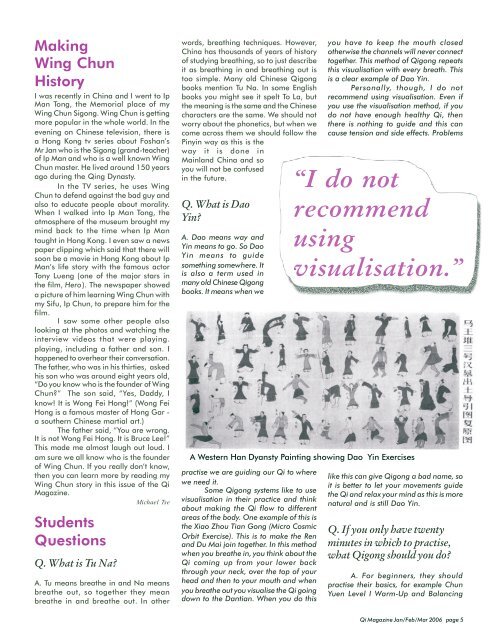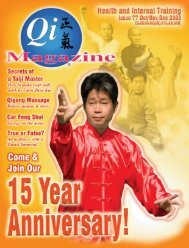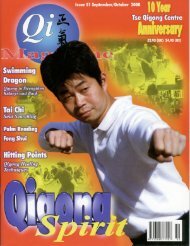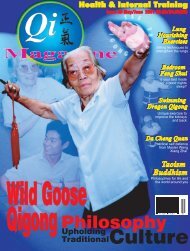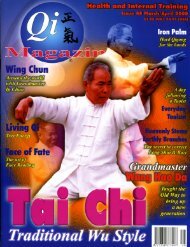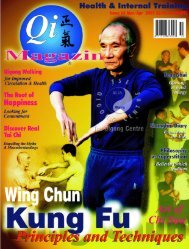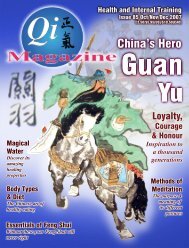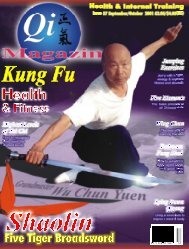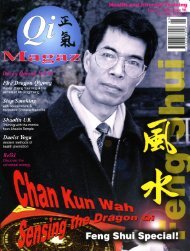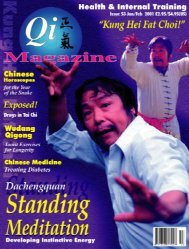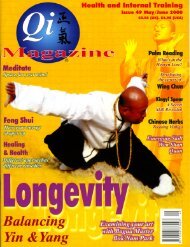Issue 78 - Tse Qigong Centre
Issue 78 - Tse Qigong Centre
Issue 78 - Tse Qigong Centre
- TAGS
- issue
- qigong
- qimagazine.com
Create successful ePaper yourself
Turn your PDF publications into a flip-book with our unique Google optimized e-Paper software.
Making<br />
Wing Chun<br />
History<br />
I was recently in China and I went to Ip<br />
Man Tong, the Memorial place of my<br />
Wing Chun Sigong. Wing Chun is getting<br />
more popular in the whole world. In the<br />
evening on Chinese television, there is<br />
a Hong Kong tv series about Foshan’s<br />
Mr Jan who is the Sigong (grand-teacher)<br />
of Ip Man and who is a well known Wing<br />
Chun master. He lived around 150 years<br />
ago during the Qing Dynasty.<br />
In the TV series, he uses Wing<br />
Chun to defend against the bad guy and<br />
also to educate people about morality.<br />
When I walked into Ip Man Tong, the<br />
atmosphere of the museum brought my<br />
mind back to the time when Ip Man<br />
taught in Hong Kong. I even saw a news<br />
paper clipping which said that there will<br />
soon be a movie in Hong Kong about Ip<br />
Man’s life story with the famous actor<br />
Tony Lueng (one of the major stars in<br />
the film, Hero). The newspaper showed<br />
a picture of him learning Wing Chun with<br />
my Sifu, Ip Chun, to prepare him for the<br />
film.<br />
I saw some other people also<br />
looking at the photos and watching the<br />
interview videos that were playing.<br />
playing, including a father and son. I<br />
happened to overhear their conversation.<br />
The father, who was in his thirties, asked<br />
his son who was around eight years old,<br />
“Do you know who is the founder of Wing<br />
Chun?” The son said, “Yes, Daddy, I<br />
know! It is Wong Fei Hong!” (Wong Fei<br />
Hong is a famous master of Hong Gar -<br />
a southern Chinese martial art.)<br />
The father said, “You are wrong.<br />
It is not Wong Fei Hong. It is Bruce Lee!”<br />
This made me almost laugh out loud. I<br />
am sure we all know who is the founder<br />
of Wing Chun. If you really don’t know,<br />
then you can learn more by reading my<br />
Wing Chun story in this issue of the Qi<br />
Magazine.<br />
Michael <strong>Tse</strong><br />
Students<br />
Questions<br />
Q. What is Tu Na?<br />
A. Tu means breathe in and Na means<br />
breathe out, so together they mean<br />
breathe in and breathe out. In other<br />
words, breathing techniques. However,<br />
China has thousands of years of history<br />
of studying breathing, so to just describe<br />
it as breathing in and breathing out is<br />
too simple. Many old Chinese <strong>Qigong</strong><br />
books mention Tu Na. In some English<br />
books you might see it spelt To La, but<br />
the meaning is the same and the Chinese<br />
characters are the same. We should not<br />
worry about the phonetics, but when we<br />
come across them we should follow the<br />
Pinyin way as this is the<br />
way it is done in<br />
Mainland China and so<br />
you will not be confused<br />
in the future.<br />
Q. What is Dao<br />
Yin?<br />
A. Dao means way and<br />
Yin means to go. So Dao<br />
Yin means to guide<br />
something somewhere. It<br />
is also a term used in<br />
many old Chinese <strong>Qigong</strong><br />
books. It means when we<br />
practise we are guiding our Qi to where<br />
we need it.<br />
Some <strong>Qigong</strong> systems like to use<br />
visualisation in their practice and think<br />
about making the Qi flow to different<br />
areas of the body. One example of this is<br />
the Xiao Zhou Tian Gong (Micro Cosmic<br />
Orbit Exercise). This is to make the Ren<br />
and Du Mai join together. In this method<br />
when you breathe in, you think about the<br />
Qi coming up from your lower back<br />
through your neck, over the top of your<br />
head and then to your mouth and when<br />
you breathe out you visualise the Qi going<br />
down to the Dantian. When you do this<br />
you have to keep the mouth closed<br />
otherwise the channels will never connect<br />
together. This method of <strong>Qigong</strong> repeats<br />
this visualisation with every breath. This<br />
is a clear example of Dao Yin.<br />
Personally, though, I do not<br />
recommend using visualisation. Even if<br />
you use the visualisation method, if you<br />
do not have enough healthy Qi, then<br />
there is nothing to guide and this can<br />
cause tension and side effects. Problems<br />
“I do not<br />
recommend<br />
using<br />
visualisation.”<br />
A Western Han Dyansty Painting showing Dao Yin Exercises<br />
like this can give <strong>Qigong</strong> a bad name, so<br />
it is better to let your movements guide<br />
the Qi and relax your mind as this is more<br />
natural and is still Dao Yin.<br />
Q. If you only have twenty<br />
minutes in which to practise,<br />
what <strong>Qigong</strong> should you do?<br />
A. For beginners, they should<br />
practise their basics, for example Chun<br />
Yuen Level I Warm-Up and Balancing<br />
Qi Magazine Jan/Feb/Mar 2006 page 5


